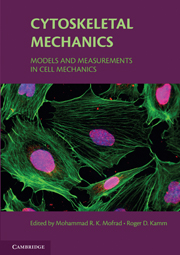Book contents
- Frontmatter
- Contents
- List of Contributors
- Preface
- 1 Introduction, with the biological basis for cell mechanics
- 2 Experimental measurements of intracellular mechanics
- 3 The cytoskeleton as a soft glassy material
- 4 Continuum elastic or viscoelastic models for the cell
- 5 Multiphasic models of cell mechanics
- 6 Models of cytoskeletal mechanics based on tensegrity
- 7 Cells, gels, and mechanics
- 8 Polymer-based models of cytoskeletal networks
- 9 Cell dynamics and the actin cytoskeleton
- 10 Active cellular protrusion: continuum theories and models
- 11 Summary
- Index
10 - Active cellular protrusion: continuum theories and models
Published online by Cambridge University Press: 10 November 2009
- Frontmatter
- Contents
- List of Contributors
- Preface
- 1 Introduction, with the biological basis for cell mechanics
- 2 Experimental measurements of intracellular mechanics
- 3 The cytoskeleton as a soft glassy material
- 4 Continuum elastic or viscoelastic models for the cell
- 5 Multiphasic models of cell mechanics
- 6 Models of cytoskeletal mechanics based on tensegrity
- 7 Cells, gels, and mechanics
- 8 Polymer-based models of cytoskeletal networks
- 9 Cell dynamics and the actin cytoskeleton
- 10 Active cellular protrusion: continuum theories and models
- 11 Summary
- Index
Summary
ABSTRACT: This chapter attempts to develop a general perspective on the phenomenon of active protrusion by ameboid cells. Except in rare special cases, principles of mass and momentum conservation require that one consider at least two phases to explain the process of cellular protrusion. These phases are best identified with the cytosolic and cytoskeletal components of the cytoplasm. A continuum mechanical formalism of Reactive Interpenetrative Flows (RIF) is contructed. It is general enough to encompass within its framework a large range of theories of active cell deformation and movement. Most physically plausible theories of protrusion fall into one of two classes: protrusion driven by cytoskeletal self-interactions; or protrusion driven by cytoskeletal–membrane interactions. These are described within the RIF formalism. The RIF formalism is cast in a form that is amenable to computer simulations through standard numerical algorithms. An example is next given of the numerical study of the most elementary protrusive event possible: the formation of a single pseudopod by an isolated round cell. Some final thoughts are offered on the role of modeling in understanding cellular mechanical activity.
Cellular protrusion: the standard cartoon
Over the past decades, experiments have consistently demonstrated that active protrusion in animal cells is accompanied by a local increase in cytoskeletal density through active polymerization. A review of the evidence for this is beyond the scope of this chapter, but key points include the high concentration of filamentous actin observed by fluorescence or EM at the leading edge of growing protrusions, as well as the abrogation of protrusion by nearly any disruption of actin polymerization, such as that caused by cytochalasin.
- Type
- Chapter
- Information
- Cytoskeletal MechanicsModels and Measurements in Cell Mechanics, pp. 204 - 224Publisher: Cambridge University PressPrint publication year: 2006
- 1
- Cited by



